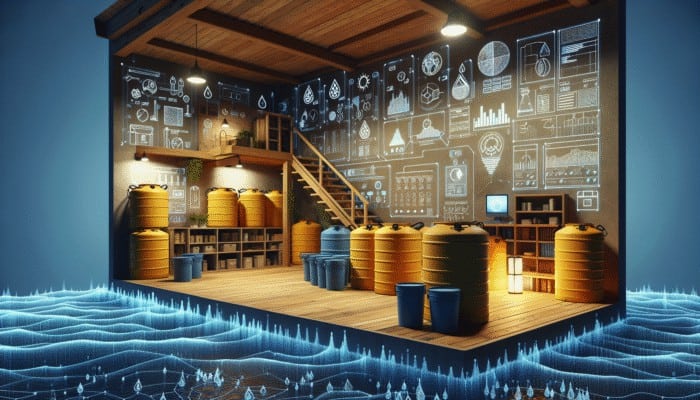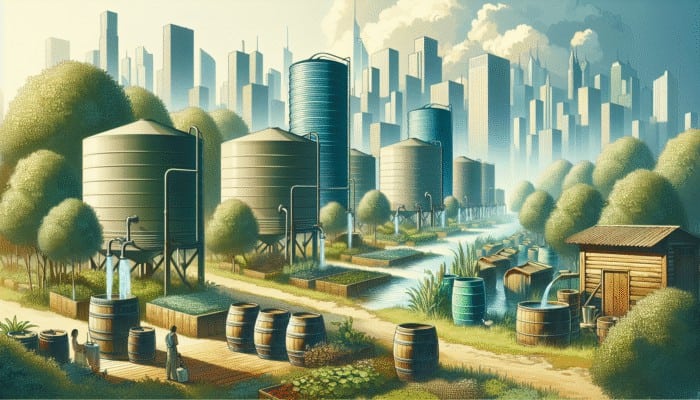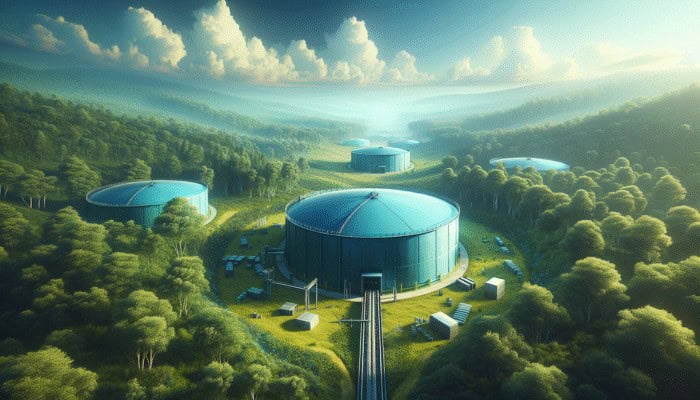The Critical Role of Water Storage in Preparedness
Understanding the Necessity of Water Storage
Water Storage Tips: Water is a fundamental necessity for human survival, yet it can become alarmingly scarce during emergencies, prolonged droughts, or unexpected disruptions in water services. Storing water serves as a crucial safety net for individuals and communities, ensuring that a dependable supply is perpetually available, which can be lifesaving.
Being prepared transcends merely stockpiling supplies; it encompasses the profound peace of mind that arises from knowing you can adequately care for yourself and your loved ones when unforeseen circumstances arise. For instance, communities with robust water storage solutions could sustain their residents effectively during natural calamities such as hurricanes or earthquakes. In contrast, those dependent on external assistance often experienced dire shortages. This compelling scenario underscores every household’s need to formulate its own comprehensive water storage plan.
Beyond emergencies, the advantages of water storage extend into daily life. By implementing reliable water storage practices, you can ensure that your everyday hygiene, cooking, and drinking requirements are consistently met without reliance on sporadic municipal water supplies. This self-sufficiency can be immensely empowering, affording individuals greater control over their resources while diminishing their vulnerability to supply disruptions. By storing water, you’re not merely preparing for potential crises but actively improving the quality of life for yourself and your family.
Listen To The Deep Dive Podcast:
Discovering the Multifaceted Benefits of Adequate Water Storage

Adequate water storage goes beyond fulfilling the basic need for hydration; it plays a vital role in supporting essential aspects of everyday life. Properly managed water supplies are crucial for maintaining hygiene practices, including handwashing and bathing, which are indispensable for public health, particularly when access to clean water is sporadic or limited. By implementing a robust water storage strategy, individuals can uphold these essential practices even amidst water shortages, significantly curtailing the risk of disease transmission and fostering a healthier community.
Furthermore, ample stored water empowers communities to prepare meals without the anxiety of depleting their resources. In regions where water scarcity can lead to increased food insecurity, storing water becomes a vital asset for not just individual households but entire communities. Families can cultivate their food, utilising stored water for irrigation and various agricultural needs. This nurturing of sufficiency encourages resilience and enables communities to flourish, even in the face of external pressures impacting their water supplies.
Strategies for Achieving Long-Term Water Security
Long-term water security fundamentally relies on implementing effective water storage strategies. Communities globally are progressively acknowledging that efficient management of water resources is paramount for sustainability. In regions such as sub-Saharan Africa, where the issue of water scarcity is particularly acute, innovative storage solutions have been deployed to optimise resource usage and secure a reliable supply. These solutions vary from expansive community cisterns to smaller, personalised barrel systems tailored to meet individual household requirements.
Investing in appropriate water storage benefits immediate users and serves as a long-term strategy for environmental stewardship. By embracing practices that promote the efficient utilisation of stored water, communities can diminish waste and prioritise sustainable management of this invaluable resource. Global water initiatives frequently highlight the significance of comprehensive water management strategies, with effective storage playing a pivotal role in achieving these objectives. Communities that prioritise water security can bolster resilience against climate change, ensuring that future generations have continued access to this essential resource.
Exploring Diverse Types of Water Storage Solutions
When contemplating water storage solutions, it is vital to explore the various options available. The most prevalent types include tanks, barrels, and cisterns, each designed to cater to different needs and capacities. Substantial tanks can be installed for rainwater harvesting, while smaller barrels may be used for household purposes. This flexibility allows individuals and communities to adapt to their specific circumstances, whether in urban or rural settings, ensuring that their water storage solutions are practical and efficient.
Additionally, the local climate and cultural practices should be considered when selecting a storage solution. In certain regions, underground cisterns are favoured for their capacity to keep water cool and minimise evaporation. Conversely, elevated tanks may be more appropriate in areas where gravity can assist in water distribution. By carefully selecting the most suitable storage solution, communities can maximise efficiency and guarantee that their water remains safe and readily accessible.
Ensuring Maintenance and Safety of Stored Water
Maintaining water storage systems is crucial to ensuring the water remains safe for consumption and use. Regular maintenance checks can help identify potential issues before they escalate, such as contamination or structural problems with storage containers. For instance, periodic cleaning of storage tanks and barrels can prevent the accumulation of algae and bacteria, thus preserving high water quality.
Safety measures also encompass the selection of appropriate materials for storage containers. Food-grade plastics, stainless steel, and glass do not leach harmful chemicals into the water. Furthermore, proper container labelling can help prevent accidental contamination and ensure that the stored water is utilised responsibly.
Ultimately, adopting a proactive approach to maintenance and safety not only preserves water quality but also instills user confidence. Knowing that the stored water is safe fosters a sense of security and encourages individuals to adopt water storage practices more widely.
Selecting the Most Suitable Water Storage Containers
Understanding the Different Types of Containers Available

Choosing the appropriate containers for water storage is paramount to ensuring the water remains safe and suitable for consumption. Containers crafted from food-grade materials such as high-density polyethylene (HDPE), stainless steel, or glass are highly recommended. These materials do not leach harmful chemicals and assist in maintaining the purity of the water over time. For example, stainless steel containers are particularly sought after in regions where durability and cleanliness are vital, as they resist corrosion and are easy to clean.
It is also crucial to consider the design of the container. Opt for containers with wide openings that facilitate easy filling and cleaning. Transparent containers can assist users in monitoring water levels and assessing the condition of the water, enabling easier detection of potential contamination. The market boasts a variety of options—from compact, stackable designs ideal for urban dwellers to larger models suitable for rural use, catering to diverse needs and preferences.
Moreover, exploring innovative designs, such as collapsible water containers, can be particularly advantageous for travellers or those with limited storage space. When selecting containers, prioritise those that have undergone testing for food safety and verify their certifications to ensure compliance with health standards.
Determining the Appropriate Size and Capacity
Choosing the right size and capacity for water storage containers is essential to effectively meeting both daily needs and emergency situations. Evaluating household consumption rates can aid in determining the optimal storage capacity. For example, an average individual may require approximately 2 gallons of water daily for drinking and cooking alone. In a household of four, this equates to a minimum of 8 gallons daily. Ensuring sufficient storage to cover at least a week’s supply can provide a buffer during emergencies, affording peace of mind.
Furthermore, considering the physical space available for storage is equally vital. Some individuals may have limited areas to store large tanks, while others may possess ample outdoor space to accommodate more extensive systems. Assessing the available space allows for more effective planning and utilisation of water storage solutions, ensuring optimal resource use. A combination of container sizes may present the most effective solution for households with varying requirements. Smaller, portable containers can be kept daily, while larger tanks can serve as backup supplies. This layered approach ensures that families can respond flexibly to changing circumstances, enhancing their water management strategies.
Focusing on Durability and Maintenance of Storage Solutions.
Durability should be a paramount consideration when selecting water storage containers. Containers must withstand external elements, temperature fluctuations, and wear over time. High-quality materials resist cracking, fading, and corrosion, ensuring the stored water remains safe for consumption. Stainless steel, for instance, is renowned for its longevity and resistance to damage, rendering it a preferred choice in many environments.
Maintenance is another critical aspect that contributes to the longevity of containers. Containers should be designed for easy cleaning, with minimal crevices that can harbour bacteria. Regular maintenance schedules can help ensure containers are cleaned and inspected for any signs of wear. For example, instituting a routine of cleaning containers every few months can significantly prolong their life and uphold water quality.
It is also beneficial to educate users on proper handling techniques. Avoiding sharp objects near storage containers and ensuring they are not exposed to sunlight for extended periods can greatly enhance durability. Individuals can fortify their water storage strategy by investing in durable, well-maintained containers and ensuring a clean water supply.
Implementing Safe Water Storage Practices
The Importance of Cleaning and Sanitising.
Regular cleaning and sanitizing of storage containers are paramount to upholding the safety of stored water. Without these essential practices, water can become a breeding ground for bacteria and other harmful pathogens. Begin by emptying the container and rinsing it with clean water. For sanitizing, a solution of unscented household bleach (one tablespoon per gallon of water) can effectively disinfect the interior surfaces. After scrubbing the container, allow the solution to sit for 30 minutes before thoroughly rinsing it with clean water, ensuring no residual bleach remains.
Implementing a cleaning schedule can help guarantee that containers remain in optimal condition. Depending on usage, consider cleaning storage containers every one to three months.More frequent cleaning may be required for those residing in areas with high sediment levels in water sourced to maintain water quality. Keeping a record of cleaning dates can be a helpful reminder and encourage consistent maintenance practices.
It is crucial to note that the cleaning process should only involve food-safe materials and methods. Avoid using harsh chemicals that can leave behind harmful residues. Additionally, ensuring that the storage area is clean and dry will help prevent contamination before storing the water, further safeguarding its quality.
Strategies for Preventing Contamination
Preventing contamination in water storage is essential for ensuring the water remains safe for consumption. One effective strategy is to utilise tight-fitting lids on containers, significantly reducing the risk of bacteria, debris, and insects entering the water supply. This simple measure can significantly diminish the likelihood of microbial growth and help maintain water purity over time. Another important practice is storing containers in a cool, dark environment. Exposure to sunlight can lead to algal growth, while elevated temperatures can promote bacterial proliferation. Ideally, containers should be kept indoors or in shaded areas, away from fluctuating temperatures and direct sunlight, thus prolonging the shelf life of stored water.
Furthermore, keeping storage containers separated from chemicals and potential contaminants is imperative. For example, storing containers near gardening supplies, cleaning chemicals, or fuels can lead to cross-contamination, jeopardising water safety. Establishing a dedicated storage area for water containers can effectively mitigate this risk, enhancing the overall safety of stored water.
Conducting Regular Inspections of Storage Systems
Regular inspections of water storage containers are vital for maintaining water quality and identifying potential issues before they escalate. Routinely check containers for cracks, leaks, or signs of wear that could compromise the integrity of the stored water. Cracks can serve as entry points for contaminants, while leaks can lead to water loss and a diminished available supply.
During inspections, assess for any unpleasant odours or discoloration in the water, which may indicate contamination. Should any irregularities be detected, it may be necessary to drain the container, clean it thoroughly, and refill it with fresh water to ensure safety.
Establishing a routine for inspections can help guarantee that the water storage system remains functional and secure. Consider setting specific intervals for biweekly or monthly checks to provide a consistent monitoring approach. This proactive strategy safeguards water quality and ensures that users can depend on their stored supplies during emergencies.
Employing Proper Storage Techniques for Optimal Quality.
Proper storage techniques can greatly enhance the quality and safety of stored water. Firstly, ensure that containers are stored off the ground. Elevating water containers reduces the risk of contamination from soilborne pathogens and helps maintain water quality over time.
Additionally, it is crucial to keep containers away from chemicals or hazardous materials. Store them in a designated area without exposure to potential pollutants, such as cleaning products or pesticides. This practice minimises the risk of cross-contamination, which can compromise water safety, ensuring that the stored water remains pure and uncontaminated.
Proper water storage also necessitates maintaining an organised setup. Labeling containers with storage dates and contents can help track the freshness of stored water. This practice allows users to implement a rotation system, ensuring that older supplies are consumed first, critical for maintaining water quality and preventing stagnation.
Implementing an Effective System of Water Rotation
Water rotation is essential for maintaining the safety and freshness of stored water. Stagnation can lead to the growth of bacteria and a decline in water quality, making it crucial to use older supplies first. Establish a system for regular rotation, ideally employing the “first in, first out” principle to ensure optimal usage.
To effectively implement this strategy, consider labelling containers with the filled dates. This labelling facilitates easy identification of which containers to use first, promoting a consistent rotation schedule. Regularly monitoring water levels can also assist in maintaining adequate supplies, ensuring you always have access to fresh water.
In addition to rotation, periodically replenishing stored water is advisable. By refilling containers with fresh water, users can ensure that their supplies remain safe and usable. This practice maintains water quality and cultivates a preparedness mindset, enhancing overall water management practices.
Understanding Water Treatment and Purification Methods
The Effectiveness of Boiling Water
Boiling water is one of the simplest yet most effective methods for treating stored water to eliminate harmful pathogens. The process is straightforward: bring water to a rolling boil for at least one minute. Extending boiling times is crucial to ensure water safety and effectiveness in areas situated at higher altitudes, where boiling points differ.
This method is particularly advantageous during emergencies when access to chemical treatments or filtration systems may be limited. Boiling is highly effective in killing bacteria, viruses, and parasites, providing peace of mind that the water is safe for drinking and cooking.
While boiling is effective, it can be time-consuming and impractical for large quantities of water. For families or communities with extensive water storage needs, boiling may not be a sustainable long-term solution. However, it remains an invaluable option for immediate treatment in critical situations where water safety is a primary concern.
Utilising Chemical Treatment for Disinfection
Chemical treatment using chlorine or iodine tablets is another effective method for disinfecting stored water. These treatments are convenient and easy to use, making them suitable for individual households and larger community initiatives.
To use chlorine tablets, adhere to the manufacturer’s instructions regarding dosage and ensure that the water sits for the appropriate time to facilitate disinfection. This method is particularly effective in areas where microbial contamination poses a significant concern, providing a reliable means of ensuring water safety.
While iodine tablets can also be effective, they may not suit everyone, particularly pregnant women or individuals with thyroid conditions. Users should consider their specific needs and potential health implications before selecting a chemical treatment method, ensuring that their approach to water safety is appropriate for their circumstances.
Exploring the Advantages of Filtration Systems
Filtration systems offer a practical solution for enhancing the taste and quality of stored water. Various filtration units, from portable systems to larger home installations, are available. These solutions can effectively remove sediment, chlorine, bacteria, and other impurities, enhancing water safety and quality.
For instance, activated carbon filters are widely recognised for improving taste and odour by removing chlorine and organic compounds. These filters can be integrated into home plumbing systems, providing a continuous supply of clean water directly from the tap, which is particularly convenient for daily use.
Portable filtering systems are especially valuable for travellers or individuals who need to purify water on the go. These systems can treat water sourced from natural bodies, such as rivers or lakes, ensuring that it is safe for consumption and enhancing overall confidence in water quality.
Investing in a quality filtration system enhances water quality and instills confidence in users, who know they possess a reliable treatment method for maintaining safe drinking water.
Leveraging Ultraviolet (UV) Purification Technology
Ultraviolet (UV) purification represents a cutting-edge method for treating stored water, employing UV light to destroy bacteria, viruses, and other pathogens. This chemical-free approach offers a safe and efficient solution for water purification, making it an appealing option for households striving to maintain high water quality standards.
UV purification systems are user-friendly and typically involve passing water through a UV lamp that emits light at a specific wavelength. The exposure to UV light disrupts the DNA of microorganisms, rendering them unable to reproduce and effectively eliminating the risk of waterborne illnesses, thus ensuring the safety of stored water.
While UV purification is highly effective, it requires electricity to operate, making it essential to consider backup power sources in emergencies. Additionally, turbidity in the water can shield pathogens from UV light, necessitating pre-filtration in instances where water quality may be compromised or questionable.
Integrating UV purification into water treatment practices can significantly enhance safety, particularly for households that prioritize clean and safe drinking water and seek to minimize contamination risk.
Implementing Effective Management of Stored Water
Establishing a System for Water Rotation and Usage
Developing a comprehensive system for rotating and using stored water is crucial for maintaining freshness and preventing stagnation. A well-organised rotation system allows users to consistently utilise older supplies first, ensuring the water remains safe and palatable for drinking and cooking.
To effectively implement this system, consider adopting a labelling strategy that includes storage dates on each container. This method lets users easily identify which containers should be consumed first, promoting a consistent approach to water usage and ensuring that supplies are not wasted.
Regularly monitoring water levels is equally vital. Tracking how much water is consumed allows users to maintain an adequate supply for both daily needs and potential emergencies. This proactive approach not only fosters preparedness mindsets but also ensures that stored water remains a reliable and accessible resource when needed.
Additionally, family members should be involved in the water management process. Educating all household members about the significance of rotating and monitoring stored water can cultivate a shared sense of responsibility and awareness regarding effective water management practices.
Strategies for Monitoring Water Levels Effectively
Monitoring water levels in storage containers is critical for ensuring adequate supplies are maintained for daily use and emergencies. Regularly checking levels helps users assess their consumption and can promptly replenish water supplies, ensuring they never run out. A visual tracking system, such as markings on the outside containers, allows for easy monitoring of water levels. This approach provides a quick reference point for assessing when to refill or rotate stored water, facilitating effective resource management.
Additionally, integrating technology can significantly enhance monitoring efforts. Innovative water monitoring systems equipped with sensors can alert users to changes in water levels, ensuring that supplies are managed efficiently. These systems can be particularly beneficial for larger storage setups or community water management initiatives, optimising water usage and ensuring emergency readiness.
By actively monitoring water levels, users can maintain a dependable supply of clean water and respond quickly to necessary replenishment, ensuring their water storage system remains functional and effective.
Preparing for Emergencies with Comprehensive Plans
A robust emergency preparedness plan for stored water is essential to ensure supplies are effectively utilised during crises. This plan should encompass rationing strategies and alternative water sources that can be tapped into as necessary, providing a comprehensive approach to water management during emergencies.
Determining how much water is required per person daily is a vital first step in this process. This calculation allows families to establish a rationing strategy conserving water while meeting essential needs. For example, in an emergency, families might allocate water primarily for hydration and hygiene, thereby reducing consumption for non-essential uses and ensuring everyone has access to the basics.
In addition to rationing, identifying alternative water sources can significantly enhance overall preparedness. This may include rainwater harvesting systems or local water bodies that can be treated and utilised in emergencies. Ensuring that all family members are educated on accessing and treating these sources is essential for bolstering resilience during challenging times.
Ultimately, creating a robust emergency preparedness plan involves educating all household members about the importance of water management and ensuring everyone understands their roles in maintaining water supplies during crises, thereby fostering greater security and readiness.
Addressing Environmental Considerations in Water Management
Promoting Sustainable Water Use Practices
Implementing sustainable water use and storage practices is essential for promoting environmental stewardship and mitigating the impacts of water scarcity. By adopting strategies that maximise the efficiency of stored water, individuals and communities can significantly reduce waste while ensuring that resources are managed responsibly.
One effective approach is to use stored water for non-potable uses, such as irrigation or household cleaning. This practice alleviates pressure on municipal water supplies and enhances overall resource management. For instance, using stored rainwater to water gardens conserves drinking water, supports plant health, and promotes biodiversity in urban and rural settings.
Moreover, employing water-saving technologies, such as garden drip irrigation systems, can optimise water use and minimise wastage. These methods of sustainable water usage contribute to long-term resource management and environmental protection, promoting a culture of conservation that benefits everyone.
Educating community members about sustainable water practices can foster collective responsibility and encourage broader participation in conservation efforts. This type of awareness is crucial for developing a culture of sustainability that prioritises responsible water management and ensures that future generations can rely on this vital resource.
Implementing Rainwater Harvesting Strategies
Rainwater harvesting is an innovative and effective strategy for enhancing overall water storage capacity while contributing to sustainability efforts. This practice involves collecting and storing rainwater from rooftops and other surfaces, providing a supplementary water source for various uses, including irrigation and household needs.
A rainwater harvesting system can significantly increase water availability for irrigation, household use, and even drinking after proper treatment. This method reduces reliance on municipal water supplies and helps alleviate pressure on local water resources, particularly in areas facing water shortages and drought conditions.
To harvest rainwater effectively, invest in a quality catchment system that includes gutters, downspouts, and storage tanks. Proper maintenance is vital to prevent contamination, and catchment surfaces should be cleaned regularly to safeguard water quality.
Rainwater harvesting also provides significant environmental benefits, as it helps reduce stormwater runoff and the potential for flooding. By capturing rainwater and storing it for later use, individuals can contribute to sustainability and resilience in their communities, fostering a more responsible approach to water management.
Choosing Eco-Friendly Water Storage Solutions
Selecting eco-friendly storage solutions is critical to minimising environmental impact while managing water supplies. Containers made from recyclable or sustainably sourced materials can significantly reduce waste and promote a circular economy that benefits the environment.
In addition to using eco-friendly materials, consider implementing practices that minimise plastic waste. For instance, opting for reusable storage containers eliminates the need for single-use plastics, which contribute to pollution and environmental degradation. This conscious choice not only aids in reducing waste but also promotes a culture of sustainability within communities.
Educating individuals on choosing sustainable water storage practices can encourage a broader commitment to environmental responsibility. Hosting community workshops that promote eco-friendly storage solutions can foster a sense of collective action toward sustainable practices, galvanising community efforts to protect the environment.
Adopting eco-friendly water storage solutions benefits the environment and cultivates a culture of responsibility and awareness within communities, ensuring that water resources are managed sustainably for future generations.
Frequently Asked Questions About Water Storage
What is the most effective way to store water for emergencies?
The most effective method for storing water for emergencies involves using food-grade containers crafted from polyethylene or stainless steel, ensuring they are clean and sealed tightly. Store these containers in a cool, dark place to maximise their shelf life and safety.
How frequently should I rotate my stored water supplies?
It is advisable to rotate your stored water every six months. Ensure that older water is used first, and replenish supplies with fresh water to maintain quality and safety and prevent potential degradation.
Is boiling water sufficient to ensure it is safe to drink?
Yes, boiling water for at least one minute effectively kills most pathogens. However, it is crucial to ensure water is boiled longer at higher altitudes, as boiling points differ, ensuring its safety for consumption.
What are the best materials for containers used in water storage?
The best materials for water storage containers are food-grade plastics, glass, and stainless steel. These options do not leach harmful chemicals into the water, preserving its purity and safety.
Can I use bleach as a sanitiser for my water containers?
Yes, using unscented household bleach diluted in water can effectively sanitise containers. A general guideline is to use one tablespoon of bleach per gallon of water for cleaning purposes, ensuring that all residues are thoroughly rinsed afterward.
How can I prevent algae growth in my stored water?
To prevent algae growth, store water containers in a cool, dark environment and ensure that they are tightly sealed to minimise light exposure, which can promote algal growth and compromise water quality.
What should I do if my stored water develops an unpleasant smell?
If stored water emits a foul odour, it may be contaminated. Drain the container, clean it meticulously, and refill it with fresh water to restore safety and quality.
How can I effectively implement rainwater harvesting?
To harvest rainwater effectively, install gutters and downspouts that direct rainwater into storage tanks. Regular maintenance and system cleaning are essential to prevent contamination and ensure safe water storage.
What is the typical shelf life of stored water?
Stored water generally has a shelf life of about 6 to 12 months, depending on storage conditions. Regularly rotating the water supply is crucial for maintaining its freshness and quality.
Are UV purification systems a worthwhile investment?
Yes, UV purification systems are effective and chemical-free, making them a valuable investment for ensuring the safety of stored water, particularly for households prioritising high water quality standards.
Explore our world on X!
Post-Disaster Bartering: Essential Strategies
Exploring the Concept of Post-Disaster Bartering What Is the Concept of Post-Disaster Bartering? Post-Disaster Bartering: Post-disaster bartering refers to the exchange of goods and services that occurs when conventional currency systems collapse due to catastrophic events, such as natural disasters, economic crises, or societal upheavals. During these critical moments, individuals and communities utilise the resources […]
Hurricane Generator Use: Powering Through Storms
Maximising the Benefits of Hurricane Generator Usage What Exactly Are Hurricane Generators? Hurricane Generator Use: Hurricane generators are advanced power supply devices specifically engineered to deliver electricity during extreme weather events, particularly during hurricanes, when standard power infrastructures may fail. These robust machines ensure that both residential and commercial establishments receive the power they need, […]
Water Collection Systems: Essential Solutions for Sustainability
Comprehensive Overview of Water Collection Systems What Exactly Are Water Collection Systems? Water Collection Systems: Water collection systems encompass a variety of innovative technologies and methodologies specifically developed to capture, store, and utilise water from diverse sources, with a primary focus on rainwater. These systems are crucial for the sustainable management of water resources, particularly in […]
Emergency Family Plan: Universal Preparation Guide
Comprehensive Elements to Include in Your Family Emergency Plan Effective Communication Strategies for Emergencies Emergency Family Plan: Establishing effective communication strategies is absolutely vital for ensuring that family members remain connected and informed during emergencies. It’s crucial to have clear, reliable methods in place that everyone understands and can utilise effortlessly. This encompasses traditional communication […]








You raise an important point about the necessity of water storage, especially in the context of community resilience. However, I can’t help but wonder about the effectiveness of the solutions being proposed. In many areas, local water management systems are outdated, and even well-intentioned storage solutions may not be enough during major crises.
You bring up a valid concern about outdated water management systems. It’s true that in many places, the frameworks meant to support our water needs haven’t kept pace with the growing challenges we face, particularly in crises.
You’ve touched on such a crucial aspect of preparedness that often goes overlooked, and I couldn’t agree more with the implications of water storage in ensuring our survival and well-being in times of crisis. Reflecting on your insights, I am reminded of how interconnected our communities become in the face of adversity. A well-prepared household doesn’t mean just securing resources for oneself; it creates a ripple effect that can inspire neighbors and friends to take similar actions, ultimately strengthening the entire community.
You’ve nailed it with your thoughts on the communal aspect of preparedness. When we talk about water storage and survival, it’s easy to focus on individual needs, but the way we prepare can indeed draw others in and foster a sense of unity. It’s fascinating how a simple act like securing extra water supplies can resonate beyond our own households.
“Absolutely, you’ve captured the essence of community resilience beautifully! If you’re looking for practical tips on water storage and preparation that can benefit not just you, but your whole neighborhood, check out this useful guide.”
https://survivalbite.com/LostFoods
Your article brings to light a vital yet often overlooked aspect of emergency preparedness. The emphasis on water storage as both a practical measure and a psychological anchor really resonates with me. It’s true that many households tend to focus on food supplies, perhaps underestimating the critical role that water plays.